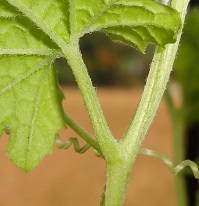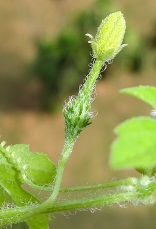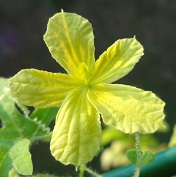| Home | Nature Weekly Index |
9 March 2014 | Momordica charantia forma abbreviata | Wild Bitter Gourd |
Bitter Gourd (Momordica charantia) is a common vegetable sold in wet market or supermarket. There is a wild form of Bitter Gourd with a much smaller fruit that can be found growing in some wild places here, and other parts of the world. It goes by the same botanical name as the cultivated version (i.e. Momordica charantia). Some have identified it as a variant with the name, Momordica charantia var. abbreviata. The cooked wild Bitter Gourd is edible but the ripe orange fruit including the seeds are toxic, according to what I have read.

 In December 2013, I found a Wild Bitter Gourd climber sprouting in my pot that housed the
Rose Catus (Pereskia grandifolia). The wild
Bitter Gourd seed must have come together with the soil as I had received the pot of Rose Catus from a relative just a few months
ago. The climber was an easy plant that did not need much care, just the usual regular watering and placing of some support for it
to climb.
In December 2013, I found a Wild Bitter Gourd climber sprouting in my pot that housed the
Rose Catus (Pereskia grandifolia). The wild
Bitter Gourd seed must have come together with the soil as I had received the pot of Rose Catus from a relative just a few months
ago. The climber was an easy plant that did not need much care, just the usual regular watering and placing of some support for it
to climb.

 As I was quite keen
to know whether there are other differences between the wild and cultivated plants besides the size of its fruit. I took some seeds
from a cultivated Bitter Gourd and sowed them in another pot. Again, the few climbers grew easily except that the pot was probably
too small for them after they started growing. Based on my observation over the last few weeks, one key distinction between the two
forms is the tiny hairs on the leaf stalk and stem. The wild form has plenty of fine long hairs while the hairs on the cultivated
form are very short, almost not visible.
As I was quite keen
to know whether there are other differences between the wild and cultivated plants besides the size of its fruit. I took some seeds
from a cultivated Bitter Gourd and sowed them in another pot. Again, the few climbers grew easily except that the pot was probably
too small for them after they started growing. Based on my observation over the last few weeks, one key distinction between the two
forms is the tiny hairs on the leaf stalk and stem. The wild form has plenty of fine long hairs while the hairs on the cultivated
form are very short, almost not visible.
There are plenty of information in the Internet about wild Bitter Gourd but most of them focus on the health properties and benefits of the plant and rarely on the difference in the botanical features of the two variants. On it medicinal value, there is a recent review article (published in February) that summarises all the available reported studies on the use of Bitter Gourd in diabetic patients. The results are still inconclusive in this treatment.
My lone wild Bitter Gourd climber has started to bear female flowers. Hopefully, the fruiting will be uneventful and I will get to see the fruits soon.